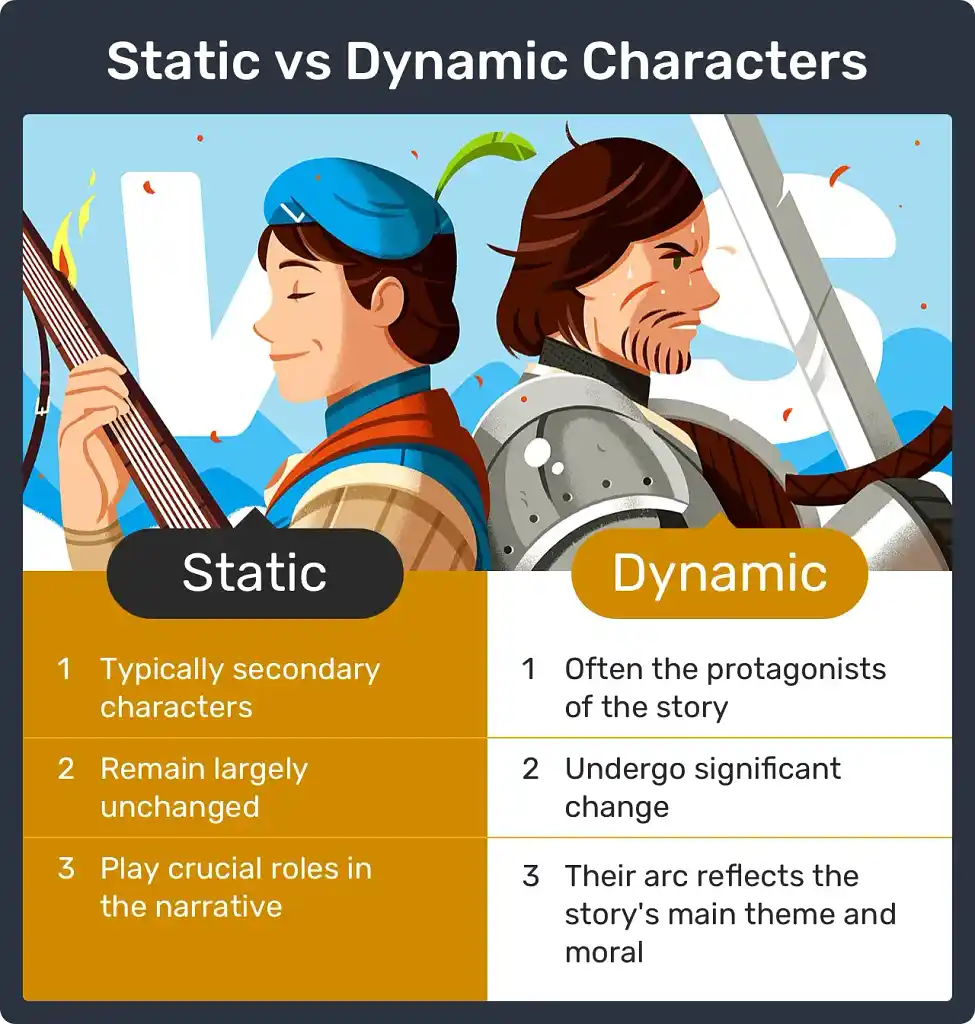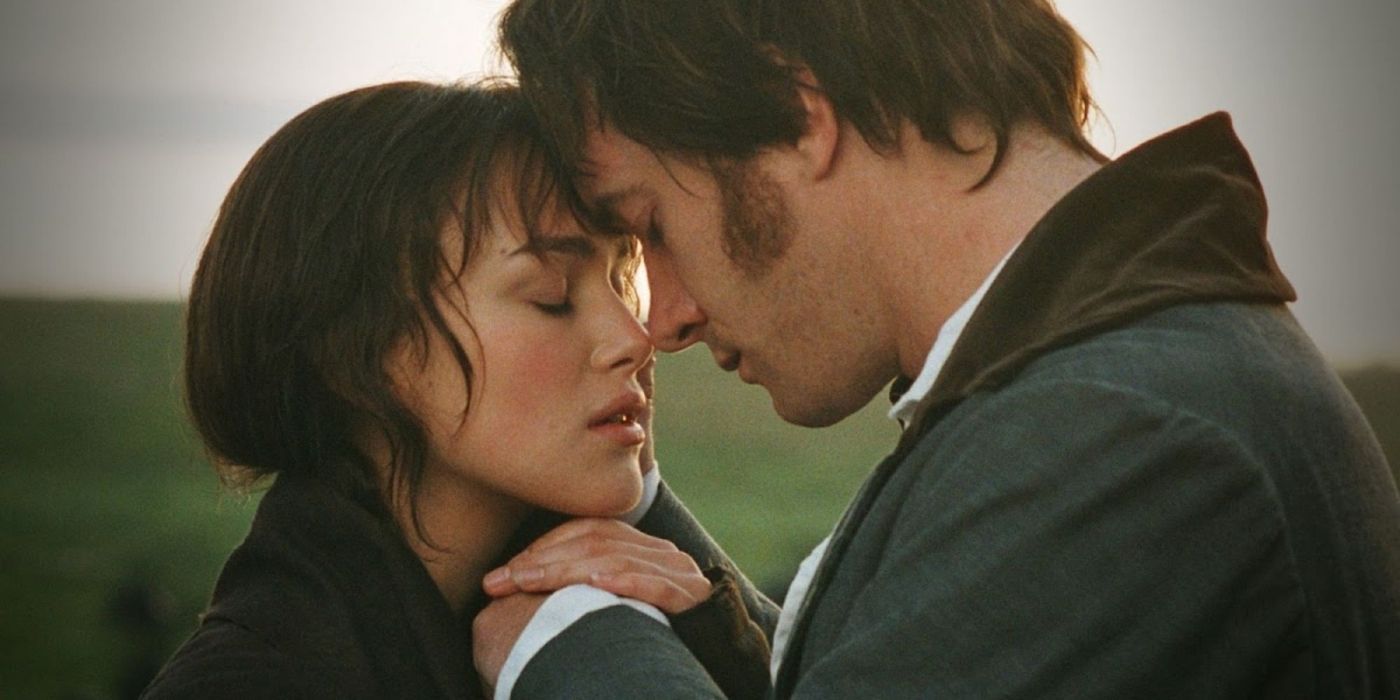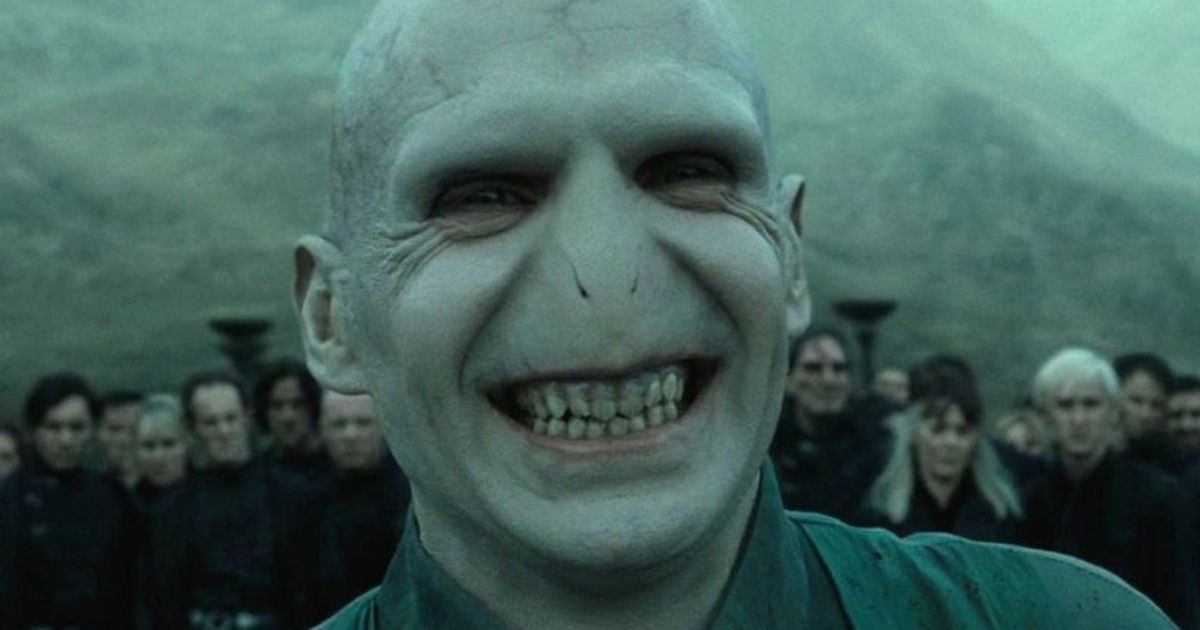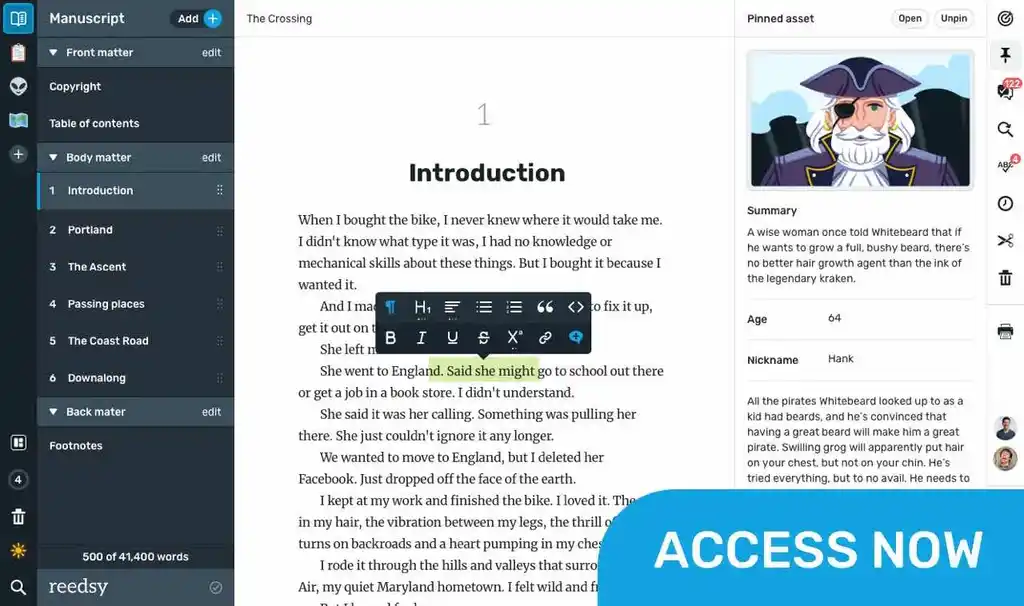All the best stories have characters that move and inspire us, in one way or another. But not all characters are the same: some are dynamic, others are static. The main difference is that dynamic characters change over the course of the story, while static ones don’t.
But there’s so much more to these characters than that. In this post, I'll cover everything you need to know about dynamic and static characters, providing well-known examples from literature and sharing practical tips to keep in mind for your novel writing.
3...2...1... action!

What are dynamic characters?
A character is considered dynamic when they evolve in some way by the end of the story, undergoing a distinct arc. The change doesn't have to be particularly dramatic or complex; it might be as simple as a grumpy character learning to appreciate the small things, or a shy kid learning how to make new friends. What matters is that the change is meaningful to them and those around them.
Crucially, this character's evolution is typically intertwined with the story plot (which is why the most dynamic character in a story is often its protagonist). Usually the dynamic character has a goal they want to achieve, which kickstarts the story and sets them on a journey in which they’ll need to overcome inner and outer obstacles. By the end, they’ll hopefully learn some important lessons and emerge a better person… or not.
Another important thing to know is that dynamic characters don't always change for the better. While they often become braver or wiser, other times they succumb to their flaws and become more resentful or evil (think Hamlet or Walter White).
Let’s get practical and look at some examples…
3 examples of dynamic characters
From niche short stories to popular epic novels, literature is filled to the brim with dynamic characters. Here are some popular ones you may be familiar with:
⚔️ Bilbo Baggins in The Hobbit
At the beginning of The Hobbit, Bilbo is nestled comfortably in his hobbit-hole in the Shire. While he secretly harbors a spark of curiosity, he's far from a brave warrior. Enter Gandalf the Grey, who appoints him as the official burglar for a perilous quest to Lonely Mountain — alongside a few brave dwarves — to reclaim a treasure from the menacing dragon Smaug.
Despite his sense of inadequacy, Bilbo bravely faces hungry trolls, giant spiders, and Smaug himself, ultimately proving himself instrumental to the group’s success. He learns that the heroic qualities he aspired to required certain circumstances to bring them out. By the time he returns to the Shire, he's wiser and more confident, and has become a hero in his own right.
💍 Elizabeth Bennet in Pride and Prejudice
In Jane Austen’s classic novel, Elizabeth Bennet starts out as a smart, witty young woman who prides herself on being socially savvy. Yet as she’s pressured by her mother to marry into wealth — and belittled by others in society, particularly Mr Darcy, in the first half of the novel — her temper and judgments get the better of her, and it seems that she will struggle to find happiness.
However, as Elizabeth opens her mind and reconsiders her previous conclusions, she comes to understand the true nature of Darcy, Wickham, and others around her. It’s only by moving past her former prejudice that she can finally find a husband she loves — and, more importantly, grow into a more mature, well-rounded person — all while retaining her witty, playful nature.

🥾 Cheryl Strayed in Wild
Throughout her memoir Wild, Cheryl Strayed recounts how hiking the Pacific Crest Trail helped her heal from a turbulent past. At the beginning, she’s a young woman devastated by her mother's death and struggling with childhood trauma. She turns to substance abuse and infidelity to cope, but after hitting rock bottom, she decides to walk the long PCT in an attempt to get better.
Along the way, she faces countless obstacles — hiking with a crushingly heavy pack, losing a shoe off a cliff, battling thirst, and enduring storms. These challenges help her reconnect with her inner strength, forgive herself for her weaknesses, and regain her integrity. Step by step (literally!), she grows into a better person.
Each of these protagonists — or in Strayed’s case, an actual person — begins their journey with flaws they need to overcome, and they work through them over the course of their story. As the reader takes this journey with them, they’ll experience much of the same intrigue, tension, and ultimate fulfillment as the protagonist — all of which makes for a satisfying narrative experience.
Now let’s look at static characters, and why they don’t change.
What are static characters?
Just because dynamic characters often take the spotlight doesn't mean static characters are necessarily less important or interesting. As I already mentioned, static characters do not evolve throughout the story. So why would authors include them in stories?
Well, static characters can play a number of pivotal roles in storytelling, especially when it comes to villains. Voldemort and Hannibal Lecter are static characters, but I doubt you’d call them dull. If anything 一 admit it 一 they made you curl deeper under your blanket with a thrill of terror. So a static character doesn’t mean a flat character (one which lacks complexity or motivation).

Moreover, any character can potentially be either static or dynamic, depending on where they start and whether they are the focus of the story or not. If you wrote about how Voldemort or Hannibal went from cute little babies to ruthless murderers, they’d be dynamic characters too.
Besides villains, static characters can also serve as foils who contrast the protagonist’s qualities (think Draco Malfoy vs. Harry Potter), interesting side characters (think Mr. Bennet in Pride and Prejudice), reliable mentors (Gandalf in The Lord of the Rings), or trustworthy leaders (Atticus in To Kill a Mockingbird).
In novels and movies, static characters are usually secondary characters, but there are certainly key exceptions in which they lead the story. Even though they don't change much (or at all), they can still be incredibly charismatic, compelling, and entertaining, making for very memorable characters.
Let’s look at some examples…
3 examples of static characters
All of the following examples are well-rounded, important characters — who, for whatever reason, do not change in the stories they’re part of.
🕵️ Hercule Poirot
Hercule Poirot is one of the most popular archetypal detectives, whose persona remains consistent from novel to novel. He is known for his elegance, mental acuity, and meticulous nature in solving all kinds of crimes. Whether he's puzzling out a murder on a train in northeastern Croatia or a steamship on the Nile, Poirot's character remains unchanged. And despite being a static character, he was most definitely a fan favorite of Christie’s readers!
🤐 Hannibal Lecter
In most of Thomas Harris’s novels, like Red Dragon and The Silence of The Lambs, Hannibal is portrayed as a highly intelligent and sophisticated psychiatrist with a taste for… his victims. He is cultured, poised, calculated, and lacks any sort of empathy.

By contrast, in Hannibal Rising, he’s the (dynamic) protagonist of the story which delves into the trauma that shaped him into such a chilling individual. Again, the character’s nature all depends on the context of the story — and it may even be a good series idea to take one of your static characters and turn them dynamic in a prequel or sequel!
🧑🚀 Mark Watney in The Martian
Mark Watney is the protagonist of Andy Weir’s acclaimed sci-fi novel The Martian, yet he is a fairly static character. Stranded on the Red Planet, he needs to find a way to survive and get back to Earth. In the face of overwhelming challenges and impossible odds, his grounding resourcefulness and scientific knowledge are what keep him alive.
Let’s wrap up with some final considerations and share tips on writing each type of character.
Dynamic characters vs. Static characters
By now, it should be clear that both dynamic and static characters have key seats at the storytelling table 一 a solid narrative requires them both!
One reason the protagonist tends to be dynamic while other characters remain static is that, as I said, a believable transformation needs to develop gradually over time, alongside the plot. Unless you're writing a series, it's challenging to build multiple plots within a single novel. It's much easier to focus on one character and one plot at a time.
In most cases, you'll “dynamify” the character who is the focus of the story and whose transformation best addresses the moral and theme of your book. You balance this dynamic character with largely static secondary characters who support their growth, whether as opponents or as allies.
So finally, let’s look into some tips on how to write these types of characters, starting with dynamic ones.
Tips for writing dynamic characters
- Give them a compelling goal: Your character needs a meaningful objective to drive their journey. This could range from seeking personal redemption to preventing an alien invasion. The goal should resonate with readers and create opportunities for growth and conflict.
- Create relatable flaws: While your protagonist should have strengths, it's crucial to include fundamental flaws that impede their progress. These could be internal struggles (like crippling self-doubt) or external challenges (such as a lack of resources). The more relatable these flaws are, the more invested readers will become in their journey.
- Craft a clear character arc: By the story's end, the character's transformation should be evident. Have they redeemed themselves or gained the skills needed to defeat the alien army? This growth is the heart of a dynamic character.
Tips for writing static characters
When it comes to static characters, on the other hand…
- Define their purpose: What roles do your secondary characters have? They might challenge the protagonist's beliefs, represent a certain ideology, or provide contrast to highlight the main character's growth. Identify which purpose each secondary character has and make sure they fulfill that purpose, rather than fading into the background
- Develop backstory and depth: Even if they don't change, static characters should feel three-dimensional. Create a rich history that explains their current state and motivations. This depth will make them more believable and impactful.
- Maintain consistency: While it can be tempting to evolve every character, once you’ve established their purpose, stick to it. Their constancy serves as a fixed point against which readers can measure the protagonist's growth.
And that’s a wrap! I hope this post has given you a better understanding of both types of characters so that now you can apply these insights to your own work, experimenting with different character dynamics to bring your narratives to life.
About the author

Martin Cavannagh is a writer, editor, and Head of Content at Reedsy. As the host of Reedsy Live, Martin has had the pleasure of sharing cutting-edge insights from some of the world's best editors, designers, marketers, and the occasional bestselling author. His newsletters, live streams, and blog posts reach millions of writers each month, inspiring the next generation of beloved writers.








